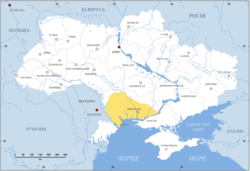Yedisan
This articleneeds additional citations forverification.(April 2023) |
Yedisan | |
|---|---|
Historical region | |
 Location of Yedisan in Ukraine | |
| Country | |
| Largest city | Odesa |
| Time zone | UTC+2(EET) |
| • Summer (DST) | UTC+3(EEST) |
Yedisan(alsoJedisanorEdisan;Ukrainian:Єдисан,romanized:Yedysan,Romanian:Edisan,Turkish:Yedisan,Russian:Едисан,romanized:Yedisan,Dobrujan Tatar:Cedĭsan) was a conditional name for Özi [Paşa] Sancağı (Ochakiv Sanjak) ofSilistra Eyalet,a territory located in today'sSouthern Ukrainebetween theDniesterand theSouthern Bug(Boh), which was placed by the Ottomans under the control of theNogai Hordein the 17th and 18th centuries and was named after one of the Nogai Hordes. In the Russian Empire, it was referred to asOchakov Oblast,while the Ottoman Turks called it simply Özü after the city ofOchakivwhich served as its administrative center. Another name used wasWestern Nogai.
Geographically, it was the western part of the so-calledWild Fieldsthat sprawled to the north of theBlack Seabetween theDniesterandDnieperrivers. It lies east ofBudjakandBessarabia,south ofPodoliaandZaporizhzhia,and west ofTaurida.Since the mid-20th century, the territory has been divided between southwesternUkraineand southeasternMoldova(southernTransnistria).
Name
[edit]
"Yedisan" is Turkic for "Seven Titles", doubtless the sept was made up of seven subgroups. Yedisan was also sometimes referred to asOchakov TartaryafterOchakov(Ochakiv), the main fortress of the region. Names for the region in different language include:Ukrainian:Єдисан [Yedysan];Russian:Едисан [Yedisan];Romanian:Edisan;Crimean TatarandTurkish:Yedisan;German:Jedisan;Polish:Jedysan.
History
[edit]
The Magyars could have been in Yedisan (Etelköz) before eventually migrating toPannonia.[1]
It was a part of historicPodolia,sometime in the 17th century it was occupied by the Ottomans partitioning betweenPodolia EyaletandSilistra Eyalet.
The area at times was incorporated into theOttoman administrative structureas part of Silistra (Özi) Eyalet with the fortresses ofKhadjibey(Odesa) andÖzi(Ochakiv) as major centers. It was also part of a larger nomadic conflict between theNogaiswho were clients of theOttoman Porteand theRussian-sponsoredZaporizhianCossacks.In the late 18th century,Imperial RussiaunderCatherine the Greatbegan to expand into the area. As a result of theRusso-Turkish War of 1768-1774,the Ottomansceded to Russiathe region east of theSouthern Bug.
Through the 1792Treaty of Jassy(Iaşi) which concluded theRusso-Turkish War of 1787-1792,the Russian frontier was extended to the Dniester River and the takeover of Yedisan was complete. Following the Russian takeover, the city ofOdesawas founded in 1794 and the area was settled as part ofNew RussiabyMoldavian,RussianandUkrainiancolonists along with a significantGermanelement. The area came to form parts of theKherson Governorateand is nowadays part of the UkrainianOdesaandMykolaivoblasts,and of the southern breakawayTransnistria(de jure part of Moldova).
See also
[edit]References
[edit]- ^Spinei, Victor (2003).The great migrations in the East and South East of Europe from the ninth to the thirteenth century.Cluj-Napoca: Romanian Cultural Institute.ISBN973-85894-5-2.OCLC57229133.
External links
[edit]- Tretiak, O.I.Birth of the city (Рождение города)(Ochakov Oblast). "Optimum". Odesa, 2004.
